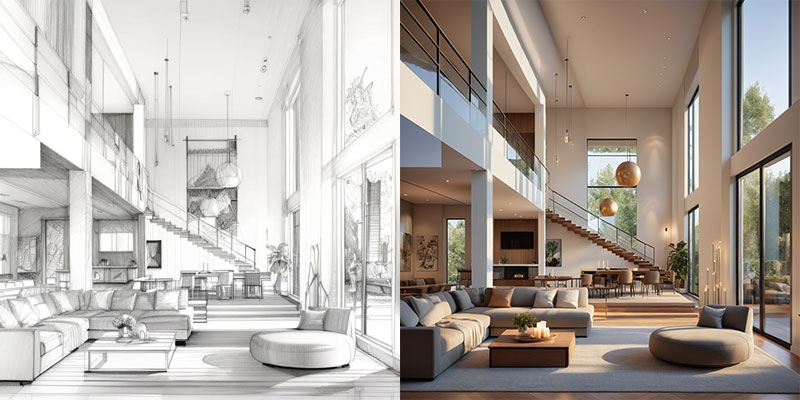Invita Amigos y Obtén Monedas Gratis para Ambos

a modern style house with large, curved roof
5349
Rod Zombie
Generador de Imágenes IA
v2
Architectural Vision:
Design a cutting-edge, solar-optimized residence with a bioclimatic structure that harmonizes with its environment. The home features a butterfly roof angled to maximize photovoltaic panel placement (40° latitude-optimized tilt) while channeling rainwater into underground cisterns. Walls are constructed from 3D-printed recycled concrete embedded with capillary tubes for passive geothermal cooling, and windows use electrochromic glass that auto-tints to balance natural light and heat gain.
Solar Integration:
Solar Skin Facade: Building-integrated photovoltaics (BIPV) mimic natural stone textures while generating 25kW peak output. Panels double as radiant heating elements in winter.
Hybrid Energy Array: A rooftop solar canopy with sun-tracking dual-axis panels pairs with vertical-axis wind turbines disguised as kinetic sculptures.
Tesla Powerwall 3 Cluster: Concealed in a climate-controlled basement vault, storing 100kWh for off-grid resilience.
Smart Energy Systems:
AI-Driven Microgrid: A central hub syncs with weather forecasts to preheat/cool the house using excess energy, prioritizing grid independence.
Hydrogen Backup: A compact electrolyzer converts surplus solar energy into green hydrogen, stored in carbon-fiber tanks for week-long autonomy.
Sustainable Water & Waste:
Living Roof Aquaponics: Integrated with greywater recycling to irrigate food-producing gardens (mangrove filters remove contaminants).
Vacuum-Assisted Composting Toilets: Reduce water use by 90%, with biogas redirected to the kitchen stove.
Passive Design Mastery:
Earth Tubes: Buried 10ft deep, these pre-condition incoming air via geothermal exchange, slashing HVAC loads.
Phase-Change Materials (PCM): Walls contain salt hydrate capsules that absorb heat by day and release it nocturnally.
Aesthetic & Functional Zones:
Sunspace Atrium: A glass-enclosed winter garden with spectral-shifting glass that amplifies photosynthesis-friendly light for indoor crops.
Thermal Mass Hearth: A basalt stone wall stores daytime solar heat, radiating warmth nightly.
Zero-Energy Pool: Heated via excess solar thermal, covered with transparent insulation by night.
Tech-Driven Livability:
Magnetic Induction Flooring: Powers appliances wirelessly while monitoring energy footprints.
Algae Bioreactor Façade: North-facing walls host algae panels that sequester CO2 and produce biofuel.
Certification-Ready:
LEED Platinum + Passive House Premium standards.
Energy Sankey Diagram: Blueprint includes a data overlay showing real-time energy flows (solar → battery → appliances → grid).
Visual Style:
Render in a crisp, technical aesthetic with exploded axonometric views highlighting systems. Use a palette of eco-tech neutrals (solar panel black, oxidized copper accents, reclaimed teak) contrasted with lush greenery.
Estilo:
Fotografía-Realismo Arquitectónico
Escena:
Edificio de Residencias,Villa
Perspectiva:
Vista Aérea
Proporción:
16:9
Iluminación:
Rayos Radiantes de Dios
0
Remix
1
Me gustaAún no hay comentarios
Más contenido similar
a modern style house with large, curved roof
5349
Rod Zombie
Generador de Imágenes IA
v2
Architectural Vision:
Design a cutting-edge, solar-optimized residence with a bioclimatic structure that harmonizes with its environment. The home features a butterfly roof angled to maximize photovoltaic panel placement (40° latitude-optimized tilt) while channeling rainwater into underground cisterns. Walls are constructed from 3D-printed recycled concrete embedded with capillary tubes for passive geothermal cooling, and windows use electrochromic glass that auto-tints to balance natural light and heat gain.
Solar Integration:
Solar Skin Facade: Building-integrated photovoltaics (BIPV) mimic natural stone textures while generating 25kW peak output. Panels double as radiant heating elements in winter.
Hybrid Energy Array: A rooftop solar canopy with sun-tracking dual-axis panels pairs with vertical-axis wind turbines disguised as kinetic sculptures.
Tesla Powerwall 3 Cluster: Concealed in a climate-controlled basement vault, storing 100kWh for off-grid resilience.
Smart Energy Systems:
AI-Driven Microgrid: A central hub syncs with weather forecasts to preheat/cool the house using excess energy, prioritizing grid independence.
Hydrogen Backup: A compact electrolyzer converts surplus solar energy into green hydrogen, stored in carbon-fiber tanks for week-long autonomy.
Sustainable Water & Waste:
Living Roof Aquaponics: Integrated with greywater recycling to irrigate food-producing gardens (mangrove filters remove contaminants).
Vacuum-Assisted Composting Toilets: Reduce water use by 90%, with biogas redirected to the kitchen stove.
Passive Design Mastery:
Earth Tubes: Buried 10ft deep, these pre-condition incoming air via geothermal exchange, slashing HVAC loads.
Phase-Change Materials (PCM): Walls contain salt hydrate capsules that absorb heat by day and release it nocturnally.
Aesthetic & Functional Zones:
Sunspace Atrium: A glass-enclosed winter garden with spectral-shifting glass that amplifies photosynthesis-friendly light for indoor crops.
Thermal Mass Hearth: A basalt stone wall stores daytime solar heat, radiating warmth nightly.
Zero-Energy Pool: Heated via excess solar thermal, covered with transparent insulation by night.
Tech-Driven Livability:
Magnetic Induction Flooring: Powers appliances wirelessly while monitoring energy footprints.
Algae Bioreactor Façade: North-facing walls host algae panels that sequester CO2 and produce biofuel.
Certification-Ready:
LEED Platinum + Passive House Premium standards.
Energy Sankey Diagram: Blueprint includes a data overlay showing real-time energy flows (solar → battery → appliances → grid).
Visual Style:
Render in a crisp, technical aesthetic with exploded axonometric views highlighting systems. Use a palette of eco-tech neutrals (solar panel black, oxidized copper accents, reclaimed teak) contrasted with lush greenery.
Estilo:
Fotografía-Realismo Arquitectónico
Escena:
Edificio de Residencias,Villa
Perspectiva:
Vista Aérea
Proporción:
16:9
Iluminación:
Rayos Radiantes de Dios
0
Remix
1
Me gustaAún no hay comentarios


























